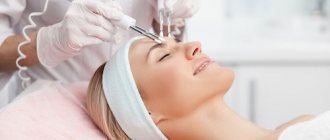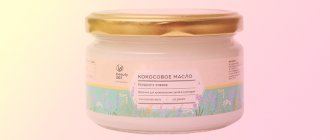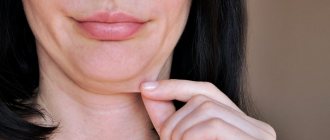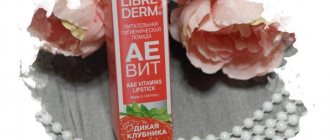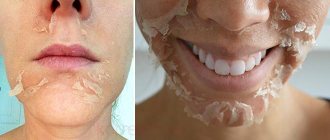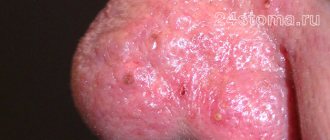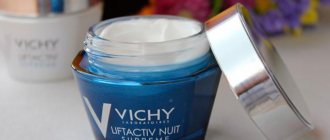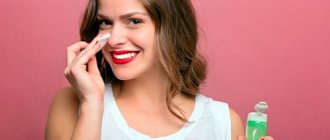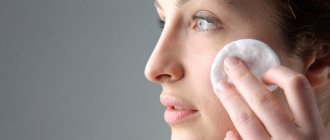Thioctic acid in cosmetology
Testimony from cosmetologists suggests that lipoic acid compounds for the skin improve the absorption of A and C.
Alpha lipoic acid is found in facial products. The main advantage of the substance is its anti-aging properties. In restorative creams and serums, ALA is used as an auxiliary ingredient. There are many cosmetic products for skin with alpha lipoic acid on the market. The beauty industry is not deprived of this, which is good news. How to choose a suitable cream containing lipoic acid? The task will be made easier by purchasing branded products.
TOP 10 preparations for facial skin with alpha lipoic acid:
- Aravia Lipoic Revitalizing Mask is a professional mask with restoration effects. Aravia Lipoic Revitalizing Mask is of Russian origin.
- Anti-aging Essenc is an anti-aging facial product with a lifting effect, produced in Switzerland.
- Laura from the company Evalar (Russian production) - cream with peptides for wrinkles.
- Creative Silver - Israeli silver mask.
- Lsme Wheitening Melasma - has a whitening effect (made in Thailand).
- Alfa Gokujyun is a Japanese professional facial product with lipoic acid.
- Antioxidant Face Creme from Nutribiotic is an imported cream made in the USA.
- FarmStay is a product with horse oil extract that produces a moisturizing effect (South Korea).
- Firming DMAE is a professional moisturizing tonic (America).
- CLC Wrinkle Away is an Israeli product with a lifting effect.
All of the above creams and other products with alpha-lipoic acid have good indications and positive reviews from cosmetologists.
Note! Before using creams, serums, etc., read the contraindications listed in the instructions.
You can buy high-quality preparations for facial skin with alpha-lipoic acid in stationary city pharmacies, specialized retail outlets, and order online.
Androgenetic alopecia – a marker of aging?
Particular attention was paid to the theory of AGA formation and the influence of aging on this process. Androgenetic alopecia (AGA)
develops over the years and is a reflection of segmental or organ-specific premature aging.
Interestingly, this process is initially triggered by sex hormones and can begin to develop quite early, already during puberty. Thus, the onset of AGA is a hormone-dependent, but not an age-associated hair disease
.
However, subsequently, the process develops and behaves similarly to the process of tissue aging - in the hair follicles, as in other organs, the proportion of cells that carry only a structural function increases, seams, constrictions, scars are formed, sclerosis occurs - increased development of connective tissue components , which leads to weakening of specific functions, thinning and loss of hair.
Use at home
Lipoic acid for facial skin has different methods of application, including participation in the preparation of home cosmetics. This is a safe and effective way to use ALA. The fact is that all the ingredients are taken independently - that is, the composition is transparent. And the effectiveness of such products is justified by the content of organic components.
Therefore, masks with the addition of lipoic acid are popular among women. Numerous reviews speak about this. With the right composition you can get rid of acne, wrinkles, sagging and other pressing problems.
This is interesting! After 20 years, the body's protection against free radicals gradually weakens, which leads to the process of premature aging. Vitamin N, which we produce ourselves, helps us cope with this task. However, with age, its reserves are depleted, so after forty years there is an urgent need for ALA.
Theories of aging
According to him, today there is no single theory of aging.
However, the most relevant theories are the following: • Free radical theory of aging
• Telomere theory
• Neuroendocrine (elevation) theory
Free radical theory was popular a few years ago, but now people doubt that it is the leading one. According to this theory, oxygen is a universal factor capable of initiating the destruction of biological tissues. Up to 2% of incoming oxygen is converted into superoxides and contributes to the formation of hydrogen peroxide.
Alpha lipoic acid in home cosmetology: recipes
Natural masks containing alpha-lipoic acid are indispensable for the dermis. The main reason for this lies in the fact that organic compounds of LA enrich the action of the other components.
Lipoic acid is actively used for face masks also because the substance is compatible with all skin types. Check out effective homemade organic recipes.
For acne
Lipoic acid gets rid of acne due to its cleansing properties. The product helps get rid of acne, neutralizes inflammation and normalizes the production of sebaceous glands.
To make a mask, we will take the following products:
- 1 ml tea tree ether;
- 1 ml LA;
- 15 ml honey, melted in a water bath;
- 1 tbsp. l. olive pressing.
When the honey has cooled, mix it with the rest of the ingredients - do not store the mixture, use it immediately. Exposure time: 15 minutes. The course consists of 10 sessions, which are held every other day. Further, maximum twice a week.
For wrinkles
The mask produces a rejuvenating effect.
Set of components:
- 1 drop of LC;
- 9 drops of vitamin C;
- 15 ml jojoba oil.
The ingredients are mixed into a homogeneous mass. After 15 minutes the mixture is washed off. Procedures are carried out for a maximum of 2 rubles. in Week.
Moisturizing effect
The mask moisturizes and nourishes - ideal for dry dermis.
Components:
- 1 tsp. aloe;
- 1 tbsp. l. pressing sea buckthorn;
- 1 ml LA;
- 3 drops vit. C.
Time: 15 minutes. Carry out twice every seven days for 30 days.
Restorative
This is a universal mask that will suit any type of dermis.
Compound:
- 1 ml LA;
- 15 ml panthenol;
- 15 ml avocado oil.
The mask is kept for 15 minutes, done twice a week for 30 days, then once every 1-2 weeks.
Microinflammation and fibrosis
It has been noted that inflammation and fibrosis may be one of the markers of aging,
both in the peripillary and perifollicular zones (see Fig. 2).
Since the process occurs in a sluggish mode, painlessly, this type is called microinflammation
. Whiting showed that the presence of microinflammation reduced the effectiveness of minoxidil treatment from 77% to 55%.
of frontal fibrous alopecia is associated with fibrosis
usually occurring in postmenopausal women.
Most often, primary fibrosis begins in the area of the mouth of the hair follicle. This localization suggests that the causative factor may be an immune response to pathogenic or opportunistic flora, most often to Propionibacterium
,
Staphylococcus
,
Malassezia.
| Rice. 2 Perifollicular inflammation |
Effect of smoking on hair
Data were also presented on the effect of smoking on the aging process. Tkachev Vladislav Petrovich noted that the role of tobacco smoking in the development of graying and hair loss in men was first noted by Mosley and Gibbs (1996). There is not yet sufficient statistical data to state that these factors have an equally negative effect on women’s hair.
The probable mechanisms of hair damage in such cases are multifactorial and are associated with the influence of tobacco smoke on the microvasculature of the hair papillae, a genotoxic effect on the DNA of hair follicles, an increase in the concentration of proinflammatory cytokines, the development of perifollicular fibrosis and microinflammation, as well as hydroxylation of estradiol, which creates a relative deficiency of active estrogens.
Factors that lead to a decrease in glutathione include:
- taking medications,
- smoking and alcohol,
- electromagnetic radiation,
- infections,
- environmental factor,
- age over 55 years,
- high consumption of refined foods.
Unfortunately, most of our food products in mass market stores are heavily filled with genetically modified compounds, preservatives, and food additives to enhance taste. All this is a regular toxic load for the body, causing serious damage to health. Fast food, pasta, baked goods, sweets, popcorn are products devoid of vitamins and amino acids, and thermophilic yeast and carcinogens used in their production lead to disruption of the intestinal microflora, and, consequently, to a decrease in the body's defense mechanisms.
Glutathione binds unwanted toxins, chemicals, and drug metabolites, providing a healing effect at any age and supporting the body's resources.
Side effects of the drug Thiogamma
Isolated reports of gastrointestinal disorders have been received: nausea, vomiting, pain in the stomach and intestines, diarrhea. In some cases, allergic reactions: skin rash, urticarial rash and itching. There are also cases of symptoms similar to hypoglycemia with vertigo, excessive sweating, headache and blurred vision. When taken orally, due to improved glucose utilization, a decrease in blood glucose levels may be noted. In isolated cases, dyspepsia and allergic skin reactions may develop. With parenteral administration, the following side effects are possible: from the nervous system and sensory organs: very rarely - convulsions, diplopia; from the blood coagulation system: possible hemorrhagic rash (purpura), thrombophlebitis; allergic reactions: urticaria or eczema at the injection site, systemic allergic reactions reactions, up to anaphylactic shock; other: as with oral administration, a decrease in blood glucose levels may be observed due to improved glucose utilization. After rapid administration of the drug, a feeling of squeezing in the head and respiratory depression may occur, but these phenomena disappear spontaneously.
Special instructions for the use of the drug Tiogamma
During therapy with Thiogamma in patients with diabetes mellitus, due to improved glucose utilization, a decrease in blood glucose levels may be noted. Therefore, regular monitoring of blood glucose levels is necessary. In some cases, it is necessary to reduce the dose of hypoglycemic agents to prevent the development of hypoglycemia. You should refrain from drinking alcohol, since under the influence of the latter the therapeutic activity of α-lipoic acid is reduced. Use during pregnancy or lactation. There is insufficient data regarding the use of the drug, therefore its use during pregnancy and breastfeeding is not recommended. Children. The effectiveness and safety of the drug in children have not been established. The effect on reaction speed when driving vehicles or other mechanisms. There are no special precautions.
To maintain glutathione production you also need to:
- Enrich the diet with foods rich in co-factors for glutathione production: animal protein (beef, poultry, fish); cruciferous vegetables; dairy products (cream, sour cream); rice bran, offal (liver, kidneys, heart), chicken eggs.
- Maintain good sleep hygiene. A good night's rest is a necessary criterion for maintaining our health and an important stimulator for the production of this antioxidant.
- Adding more exercise to your life is a wonderful way to speed up your metabolism and increase glutathione production. Any aerobic activity (running, swimming, brisk walking, cycling) will be a great start to this8.
Glutathione reserves are restored on their own, but the realities of our days are such that the toxic load exceeds the resource and we need daily additional intake.
Unfortunately, exogenous forms of glutathione are not absorbed: under the influence of hydrochloric acid in the stomach, this compound instantly breaks down into amino acids, without producing the desired effect.
L-methionine and melatonin
Recent studies have shown the role of L-methionine
in preventing the oxidation of melanin by peroxide in vitro. Thus, supplementation with this amino acid may be promising for the prevention of graying. .
melatonin attracts attention
, as a potential antioxidant. Melatonin is a radical scavenger and a factor in the fight against tissue aging. In cultured human keratinocytes, melatonin has been shown to have multiple biological effects and enhance their proliferation. Hipler 2003 showed that melatonin effectively prevents the development of UV-induced erythema in humans. Recent studies have shown that the antioxidant effectiveness of melatonin is higher than that of vitamin C. The melatonergic system in human skin counteracts environmental stress factors and ensures homeostasis of both skin and hair. 2004 showed that external use of a melatonin solution can prolong the anagen phase in women with AGA and diffuse hair loss.
The effect of using Tiogamma for the face
- The active ingredient activates the natural production of collagen and accelerates the function of cell restoration. Under its influence, the dermis is deeply saturated with oxygen, which provides the skin with elasticity and firmness.
- If you regularly apply the product to cleansed facial skin, morning and evening, the depth of wrinkles is noticeably reduced, and small expression lines completely disappear. The skin is rejuvenated, the size of the pores decreases, the skin of the face takes on a radiant appearance, becomes smoother, as if polished, dark circles and bags under the eyes also disappear.
- Roughness, marks and post-acne scars are smoothed out well, the skin texture is evened out and takes on a natural and healthy appearance.
